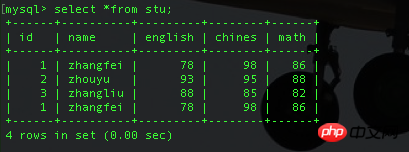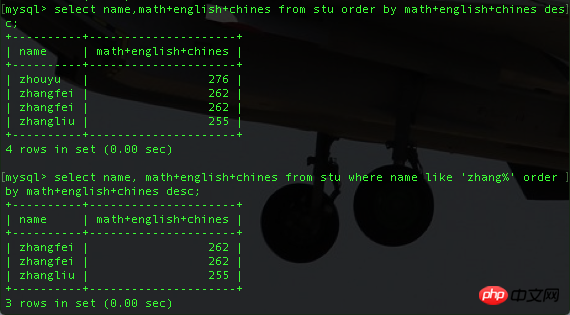SQL 집계 함수 및 정렬
이번에는 SQL의 aggregation함수와 정렬에 대해 알려드리겠습니다. SQL 집계 함수 및 정렬 사용 시 주의사항은 무엇인가요?
count 함수
구문:
Select count(*)|count(列名) from table_name [where where_defination];Select count(id) from stu;Select count(name) from stu where math > 90;select count (name) from stu where chines+math+English> 250;
sum 함수
Select sum (列名) from stu [where where_defination]; Select sum (列名),sum(列名), sum(列名) from stu [where where_definition]; Select sum (列名)+sum(列名)+ sum(列名) from stu [where where_definition]; Select sum (列名)+sum(列名)+sum(列名) as 总分 from stu [where where_definition]; Select sum (列名)/count(name) from stu [where where_defination]; Select avg(math) from stu; Select avg(math + chines + english) from stu; Select max|min(列名) from stu; Select max(math + chines + english) from stu; Select min(math + chines + english) from stu;
정렬 queryresults
쿼리 결과를 정렬하려면 order by 절을 사용하세요.
Select column1, column2, column3 from table order by column asc|desc
order by는 정렬할 열을 나타냅니다. 또는 select
order by 절 뒤에 지정된 열 이름은 select 문의 끝에 위치해야 합니다
Select name, math from stu order by math; select name, math+english+chines from stu order by math+english+chines desc; select name, math+english+chines from stu where name like 'zhang%' order by math+english+chines desc;


이 기사의 사례를 읽은 후 방법을 마스터했다고 믿습니다. 흥미로운 정보가 있으니 PHP 중국어 웹사이트의 다른 관련 기사도 주목해 주세요!
추천 도서:
위 내용은 SQL 집계 함수 및 정렬의 상세 내용입니다. 자세한 내용은 PHP 중국어 웹사이트의 기타 관련 기사를 참조하세요!

핫 AI 도구

Undresser.AI Undress
사실적인 누드 사진을 만들기 위한 AI 기반 앱

AI Clothes Remover
사진에서 옷을 제거하는 온라인 AI 도구입니다.

Undress AI Tool
무료로 이미지를 벗다

Clothoff.io
AI 옷 제거제

AI Hentai Generator
AI Hentai를 무료로 생성하십시오.

인기 기사

뜨거운 도구

메모장++7.3.1
사용하기 쉬운 무료 코드 편집기

SublimeText3 중국어 버전
중국어 버전, 사용하기 매우 쉽습니다.

스튜디오 13.0.1 보내기
강력한 PHP 통합 개발 환경

드림위버 CS6
시각적 웹 개발 도구

SublimeText3 Mac 버전
신 수준의 코드 편집 소프트웨어(SublimeText3)

뜨거운 주제
 7461
7461
 15
15
 1376
1376
 52
52
 77
77
 11
11
 44
44
 19
19
 17
17
 17
17
 golang 함수에서 새 함수를 동적으로 생성하기 위한 팁
Apr 25, 2024 pm 02:39 PM
golang 함수에서 새 함수를 동적으로 생성하기 위한 팁
Apr 25, 2024 pm 02:39 PM
Go 언어는 클로저와 리플렉션이라는 두 가지 동적 함수 생성 기술을 제공합니다. 클로저는 클로저 범위 내의 변수에 대한 액세스를 허용하며 리플렉션은 FuncOf 함수를 사용하여 새 함수를 생성할 수 있습니다. 이러한 기술은 HTTP 라우터를 사용자 정의하고 고도로 사용자 정의 가능한 시스템을 구현하며 플러그 가능한 구성 요소를 구축하는 데 유용합니다.
 C++ 함수 이름 지정 시 매개변수 순서에 대한 고려 사항
Apr 24, 2024 pm 04:21 PM
C++ 함수 이름 지정 시 매개변수 순서에 대한 고려 사항
Apr 24, 2024 pm 04:21 PM
C++ 함수 이름 지정에서는 가독성을 높이고 오류를 줄이며 리팩토링을 용이하게 하기 위해 매개변수 순서를 고려하는 것이 중요합니다. 일반적인 매개변수 순서 규칙에는 작업-객체, 개체-작업, 의미론적 의미 및 표준 라이브러리 준수가 포함됩니다. 최적의 순서는 함수의 목적, 매개변수 유형, 잠재적인 혼동 및 언어 규칙에 따라 달라집니다.
 Java로 효율적이고 유지 관리 가능한 함수를 작성하는 방법은 무엇입니까?
Apr 24, 2024 am 11:33 AM
Java로 효율적이고 유지 관리 가능한 함수를 작성하는 방법은 무엇입니까?
Apr 24, 2024 am 11:33 AM
효율적이고 유지 관리 가능한 Java 함수를 작성하는 핵심은 단순함을 유지하는 것입니다. 의미 있는 이름을 사용하세요. 특별한 상황을 처리합니다. 적절한 가시성을 사용하십시오.
 Excel 함수 수식의 전체 모음
May 07, 2024 pm 12:04 PM
Excel 함수 수식의 전체 모음
May 07, 2024 pm 12:04 PM
1. SUM 함수는 열이나 셀 그룹의 숫자를 합하는 데 사용됩니다(예: =SUM(A1:J10)). 2. AVERAGE 함수는 열이나 셀 그룹에 있는 숫자의 평균을 계산하는 데 사용됩니다(예: =AVERAGE(A1:A10)). 3. COUNT 함수, 열이나 셀 그룹의 숫자나 텍스트 수를 세는 데 사용됩니다. 예: =COUNT(A1:A10) 4. IF 함수, 지정된 조건을 기반으로 논리적 판단을 내리고 결과를 반환하는 데 사용됩니다. 해당 결과.
 C++ 함수 기본 매개변수와 가변 매개변수의 장단점 비교
Apr 21, 2024 am 10:21 AM
C++ 함수 기본 매개변수와 가변 매개변수의 장단점 비교
Apr 21, 2024 am 10:21 AM
C++ 함수에서 기본 매개변수의 장점에는 호출 단순화, 가독성 향상, 오류 방지 등이 있습니다. 단점은 제한된 유연성과 명명 제한입니다. 가변 매개변수의 장점에는 무제한의 유연성과 동적 바인딩이 포함됩니다. 단점은 더 큰 복잡성, 암시적 유형 변환 및 디버깅의 어려움을 포함합니다.
 C++ 함수 예외 고급: 사용자 정의된 오류 처리
May 01, 2024 pm 06:39 PM
C++ 함수 예외 고급: 사용자 정의된 오류 처리
May 01, 2024 pm 06:39 PM
C++의 예외 처리는 특정 오류 메시지, 상황별 정보를 제공하고 오류 유형에 따라 사용자 지정 작업을 수행하는 사용자 지정 예외 클래스를 통해 향상될 수 있습니다. 특정 오류 정보를 제공하려면 std::Exception에서 상속된 예외 클래스를 정의하세요. 사용자 정의 예외를 발생시키려면 throw 키워드를 사용하십시오. try-catch 블록에서 Dynamic_cast를 사용하여 발견된 예외를 사용자 지정 예외 유형으로 변환합니다. 실제 경우 open_file 함수는 FileNotFoundException 예외를 발생시킵니다. 예외를 포착하고 처리하면 보다 구체적인 오류 메시지가 제공될 수 있습니다.
 사용자 정의 PHP 함수와 사전 정의된 함수의 차이점은 무엇입니까?
Apr 22, 2024 pm 02:21 PM
사용자 정의 PHP 함수와 사전 정의된 함수의 차이점은 무엇입니까?
Apr 22, 2024 pm 02:21 PM
사용자 정의 PHP 함수와 사전 정의된 함수의 차이점은 다음과 같습니다. 범위: 사용자 정의 함수는 정의 범위로 제한되는 반면, 사전 정의된 함수는 스크립트 전체에서 액세스할 수 있습니다. 정의 방법: 사용자 정의 함수는 function 키워드를 사용하여 정의되는 반면, 사전 정의된 함수는 PHP 커널에 의해 정의됩니다. 매개변수 전달: 사용자 정의 함수는 매개변수를 수신하지만 사전 정의된 함수에는 매개변수가 필요하지 않을 수 있습니다. 확장성: 필요에 따라 사용자 정의 함수를 생성할 수 있으며 사전 정의된 함수는 내장되어 있어 수정할 수 없습니다.
 C++ 함수에서 참조 매개변수 및 포인터 매개변수의 고급 사용
Apr 21, 2024 am 09:39 AM
C++ 함수에서 참조 매개변수 및 포인터 매개변수의 고급 사용
Apr 21, 2024 am 09:39 AM
C++ 함수의 참조 매개변수(기본적으로 변수 별칭, 참조를 수정하면 원래 변수가 수정됨)와 포인터 매개변수(원래 변수의 메모리 주소 저장, 포인터 역참조를 통해 변수 수정)는 변수를 전달하고 수정할 때 사용법이 다릅니다. 참조 매개변수는 생성자나 할당 연산자에 전달될 때 복사 오버헤드를 피하기 위해 원래 변수(특히 대규모 구조)를 수정하는 데 자주 사용됩니다. 포인터 매개변수는 메모리 위치를 유연하게 가리키거나, 동적 데이터 구조를 구현하거나, 선택적 매개변수를 나타내기 위해 널 포인터를 전달하는 데 사용됩니다.




